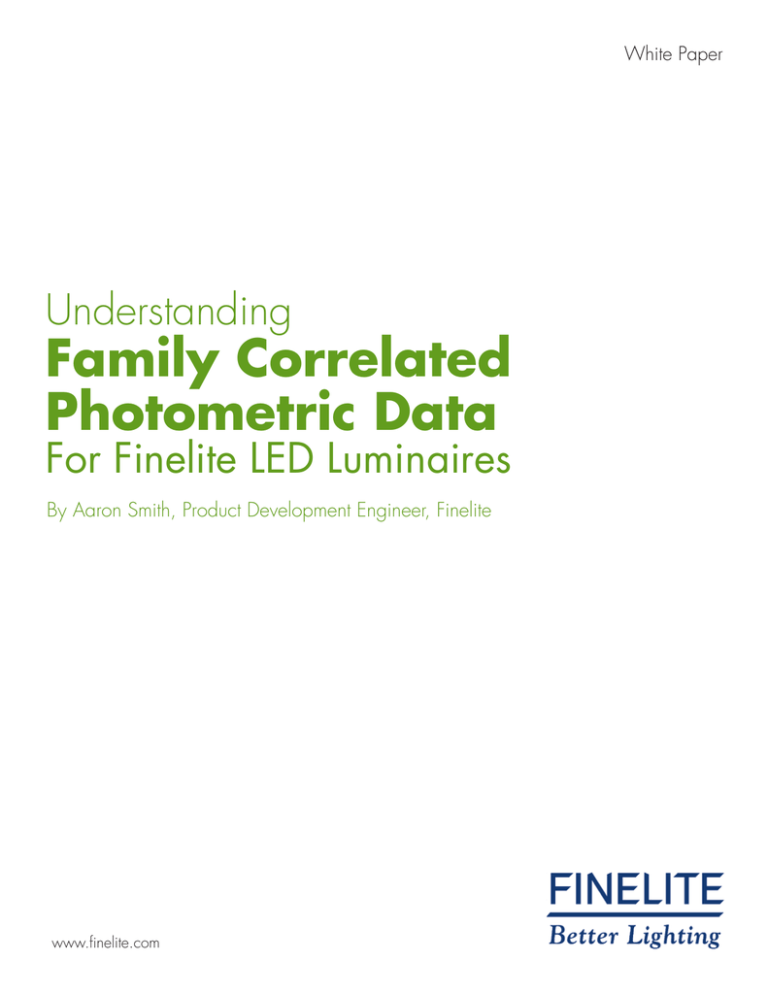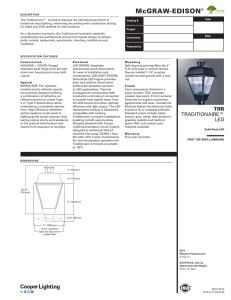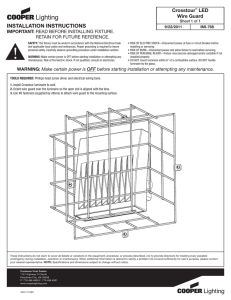
White Paper
Understanding
Family Correlated
Photometric Data
For Finelite LED Luminaires
By Aaron Smith, Product Development Engineer, Finelite
www.finelite.com
Introduction
The US Department of Energy (DOE) acknowledges that as the LED market has
matured, lighting manufacturers have developed methods to accurately calculate
product performance within a product family. Creating a calculated set of results helps
manufactures and customers by reducing testing costs without sacrificing the quality
of the products or the ability to accurately calculate lighting performance.
This paper describes Finelite’s approach to creating a family of LED luminaires. It will
discuss what a family is, identify what performance characteristics scale well and which
do not, provide examples of how family calculations are applied, and outline the reports
made from these family calculations.
Family correlation is currently being supported by groups such as The U.S. Department of
Energy, Lighting Facts® (a program of the U.S. DOE), and the Design Lights Consortium®
(a project of the Northeast Energy Efficiency Partnerships).
What is a family of products?
Finelite’s fixture families are groups of luminaires where the critical metrics, including
photometric, thermal, life, and electrical performance, can be accurately scaled using a
combination of LM-79 tests at the luminaire level and well documented specifications at
the component level.
The following luminaire characteristics scale well.
4000K •
3500K •
3000K
Lumen differences due to LED color temperature
• LEDs are available in different color temperatures. The color temperature of the LED
affects its lumen output; these lumen differences scale well, and are easily calculated.
Lumen differences due to LED technology improvements
• LED manufacturers regularly update chip performance. Improvements to the lumen
performance of a chip that do not affect thermal performance and life will allow for
predictable scaling of the lumen output of the luminaire.
Equal driver performance specification
• Equal performance should be expected.
• Power supplies may be specified from different manufacturers for any number of
application reasons or because new improved drivers enter the market and offer
overall enhanced performance. Changing a driver used in a luminaire will not impact
the performance of the luminaire when operated within its performance specification.
Driver 1
Manufacturer A
700 mA
40 watts
2
Understanding Family Correlated Photometric Data For Finelite LED Luminaires
=
Driver 2
Manufacturer B
700 mA
40 watts
Luminaire Characteristics & Scaling
Lumen differences due to programmable power supplies
• Programmable supplies allow LEDs to be driven at a range of currents and
lumen outputs.
• The thermal and lifetime performance will improve as LED current is reduced from
the max operating specification of the luminaire. The lumen performance scales well
and is easily calculated.
700 mA
The following luminaire characteristics do not scale well.
Changes to the luminaires optics
• When the optics of a luminaire change, the distribution of the luminaire will be
different. Therefore any changes to the luminaire that would change the
distribution would not scale well.
• Optics can be changed in a variety of ways including, but not limited to, changes
to materials, secondary optics, diffusers, and reflector systems.
Operating the LED beyond the specified rated operating conditions
of the luminaire
• The fixture design and the LED array design are matched to provide a specified
performance. Operating the LEDs beyond this matched performance may subject
the LEDs to non linear thermal effects which makes predicting the lumen output less
predictable and therefore would not scale well.
Changing the LED chip type
• Changing the LED chip type may change the distribution of the luminaire and
therefore this change does not scale well.
Reflector Difference
=
Any alteration to the luminaire that results in a change to the optical design or any
change that would exceed the maximum designed electrical or thermal performance
of the current luminaire family definition would not scale well, and a new family
definition, requiring new testing and scaling profiles, would be required.
How is the calculation method applied?
For each luminaire family, Finelite uses LM-79 test data gathered by an independent
testing lab from one member of the family, calculations of luminaire efficiency, and
individual LED lumen data to create Finelite’s family correlated photometry files. This
method takes into account the thermal stabilization of the luminaire required for
LM-79 testing, and the efficiency of the LED chip for different drive currents and color
temperatures. Independent thermal and electrical tests are also conducted on the
highest-power luminaire in the family. Finelite uses its own calibrated thermal and
electrical testing equipment to verify the thermal and electrical performance of luminaires
not independently tested. This data is used to spot-check and validate the family
correlation model. Finelite also works with its partners to verify the performance of the
LEDs that make up the lighting panels installed in its luminaires.
3
Understanding Family Correlated Photometric Data For Finelite LED Luminaires
460
345
230
115
200 mA
Implementation
Step 1: Assemble the data
Our first step is to assemble the independently
verified data.
• LM-79 reports from an NVLAP-qualified test lab for
one color temp of the representative luminaire
in the family.
• LED chip performance data from LED manufacturer.
LM-79 report
LED chip performance data
Step 2: Calculate luminous flux per chip for each
color temperature (CCT)
We use the data from the LED specification provided by the LED
manufacturer to calculate the lumens produced per chip for each
available color temperature.
Lumen Output
Lumens
60.0
4000K
y = 0.3514x + 2.6921
R² = 0.9996
50.0
3500K
y = 0.337x + 2.6641
R² = 0.9996
40.0
3000K
y = 0.3226x + 2.636
R² = 0.9996
30.0
20.0
Lumens per LED are calculated for
each color temperature (CCT) based
on the electrical current delivered to
each LED. The chart to the right is a
sample summary of those calculations.
10.0
4000K
3500K
0.0
3000K
0
20
40
60
80
100
Forward Current If (ma)
4
Understanding Family Correlated Photometric Data For Finelite LED Luminaires
120
140
160
Implementation
Step 3: Use the luminous flux information to calculate
the lumens per color temp for each luminaire
in the family.
We use the data available in the LED specification from the LED manufacturer to calculate the lumens produced per chip for each available color
temperature. This data is used to develop a spreadsheet showing lumen
output for each luminaire in the family.
A
LM79 Test
Family Correlated Data
Calculated LED Lumens
A
The projected LED lumens is the total number of lumens generated
in a 100% efficient luminaire, which is calculated by multiplying
the lumens per LED by the total number of LEDs in the luminaire.
B
Calculated Fixture Efficiency
C
Calculated Lumen Output
Fixture efficiency is calculated using the projected LED lumens and
the tested output from one luminaire.
The projected LED lumens is multiplied by the fixture efficiency to
determine the lumen output for the luminaire.
Formula:
A
X
B=C
(Calculated Lumen Output)
Step 4: Output IES file for simulation
Finelite provides family correlated files and they can be downloaded
from each product page at www.finelite.com.
5
Understanding Family Correlated Photometric Data For Finelite LED Luminaires
BC
Q&A
Q: Can I get an IES File for products that have correlated data?
A: Yes, IES files are generated by combining independent testing performance with
family correlation data.
Q: Can I get an IES File for a specific lumen output for the luminaire for my project?
A: Yes
Q: Will Finelite share the scale factors used and the backup data with customers?
A: Yes, we are transparent
Q: How close is the correlated data to an actual test?
A: Calculated lumen output is within ±10%. The lumen output ±10% shows
better accuracy compared to fluorescent luminaires systems.
For more information refer to U.S. Department of Energy’s report on
“Lumen Maintenance and Light Loss Factors”.
Q: Can you create family correlations for different luminous outputs?
A: Yes. Knowing the fixture efficiency and individual LED lumens at a given input
current allows the calculation of alternative luminous outputs.
6
Finelite, Inc. • 30500 Whipple Road • Union City, CA 94587-1530 • 510 / 441-1100 • Fax: 510 / 441-1510 • www.finelite.com
© 2014 Finelite Inc. • All rights reserved. 04/14




